Big Banks Shift to Lower Gear Banking Operations
Companies / Banking Stocks Aug 01, 2014 - 04:11 PM GMTBy: John_Mauldin
 For today’s Outside the Box, good friend Gary Shilling has sent along a very interesting analysis of the big banks. Gary knows a lot about what went down with the big banks during and after the Great Recession, and he tells the story well.
For today’s Outside the Box, good friend Gary Shilling has sent along a very interesting analysis of the big banks. Gary knows a lot about what went down with the big banks during and after the Great Recession, and he tells the story well.
After the bailout of banks during the financial crisis, many wanted too-big-to-fail institutions to be broken up. Big banks resisted and pointed to their rebuilt capital, but regulators are responding with restraints that strip them of proprietary trading and other lucrative activities and push them towards spread lending and other traditional commercial banking businesses. The fiasco at Citigroup, JP Morgan's London Whale, and BNP Paribas's sanctions violations have spurred regulators as well.
Regulators are pressured to impose big fines and get guilty pleas for infractions. Meanwhile, big bank deleveraging proceeds. In this new climate, big banks are still profitable but at reduced levels and are moving toward utility and away from growth-stock status. The end of mortgage refinancing and weak security trading are also drags.
Banks are reacting by taking more risks, but regulators are concerned as long as depositors’ money is at risk. Still, regulators want to keep big banks financially sound and profitable enough to serve financial needs.
Gary’s analysis is extensive and thorough, but it’s only one part of his monthly Insight report. If you subscribe to Insight for $335 via email, you'll receive a free copy of Gary Shilling's full report on large banks, excerpted here, plus 13 monthly issues of Insight (for the price of 12), starting with their August 2014 report.
To subscribe, call them at 1-888-346-7444 or 973-467-0070 between 10 AM and 4 PM Eastern time or email insight@agaryshilling.com. Be sure to mention Outside the Box to get your free report on the big banks. (This offer is for new subscribers only.)
I am back from Whistler, British Columbia, where I spent the weekend at Louis Gave’s 40th birthday party. I went to Louis’s new home on the mountain, where you can ski down and take the gondola back up when you want to go home. Sunday afternoon Louis and I sat and talked for a few hours about the state of the world, interrupted now and again by the excitement of the children when a mother bear and cub walked through the yard. Later we saw another mother with two cubs.
The conversation drifted to the state of the investment industry in which we both work. It echoed similar conversations I have had over the world with other market participants. There is a growing feeling (admit it, you probably feel it too) that significant changes in the investment business are coming at us rather swiftly. Everywhere I go people are trying to figure out what those changes will entail. I’m not talking about just another bear market. In the same way, much of the music industry was sitting fat and happy in 2000 – they had little idea that Napster was just around the corner. And while Napster came and went, the way that people consume music today is significantly different than it was 10 or 15 years ago.
I have the feeling that the investment industry is getting ready to be hit by its equivalent of Napster. I’m not quite sure what that ultimately means, other than in 10 years (or maybe less) clients will be consuming their investment research and advice in a different manner. Old dogs are going to have to learn new tricks or be retired to the porch. And I am not ready to retire, so I will need to master a few new tricks, I guess. Of course, I would like to avoid Napster and go straight to Spotify. Then again, wouldn’t we all?
As Louis drove us back to the hotel – past more bears – he remarked that one does have to be careful around them. “Not really,” I said. “I have run with more than a few bears in my life and been OK.” He looked at me rather strangely, and I added. “Yeah, like Marc Faber, Gary Shilling, Rosie in his former life. Those were REAL bears. These are just cute animals.” He smiled and kept driving.
I will write my next note from Maine, where my son Trey and I will be going to fish for the 8th year in a row at what has become known as Camp Kotok. And though they tell me they are all around us there, the only bears I have seen are some of my fellow campers.
Your ready to lose the fishing contest again,
John Mauldin, Editor
Outside the Boxsubscribers@mauldineconomics.com
Big Banks Shift to Lower Gear
(Excerpted from the July 2014 edition of A. Gary Shilling's INSIGHT)
In February 2007, the subprime mortgage bubble broke (Chart 1). Big British bank HSBC was forced to take a $1.8 billion writedown on its U.S. Household subprime lending unit's bad loans, at the time an unprecedented amount, and subprime mortgage lender New Century reported disappointing fourth quarter results.
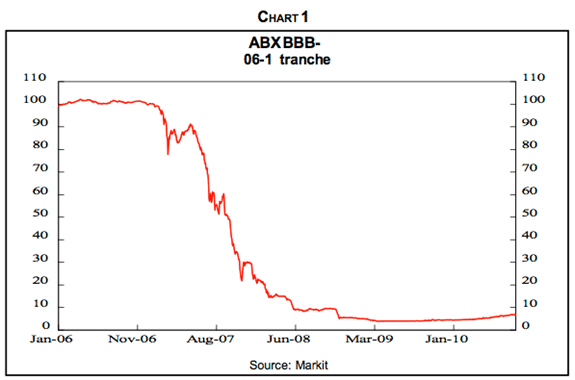
Quick Spreading
At the time, many housing bulls tried to convince us that the problem was limited to subprime loans that were made to people they, luckily, would never have to meet. But it spread to Wall Street. Bear Stearns was laden with subprime-related securities and when market lenders refused to finance the firm, the New York Fed provided $30 billion in short-term financing. On March 16, 2008, the firm merged with JP Morgan Chase bank in a stock swap worth $2 per share, only 7% of its value two days earlier and 1% of the $172 a share price for Bear Stearns in January 2007. Morgan bank paid $1 billion and the New York Fed was stuck with $29 billion.
Lehman Brothers was next. But this time, the Fed and the Bush Administration refused to bail out that firm and it filed for bankruptcy on September 15, 2008 when outside financing of its hugely leveraged portfolio disappeared and its net worth was a negative $129 billion.
With a meltdown of major Wall Street firms in prospect that probably would have spread worldwide, the Fed and the Administration twisted Congress’ arms into passing the Troubled Asset Relief Program. TARP originally authorized $700 billion to finance troubled assets but it soon morphed into a bailout fund for banks and other troubled financial institutions and took equity positions in 707 banks. The objective was to stabilize their balance sheets and encourage them to lend.
Some $475 billion of TARP money was disbursed and all but $40 billion has been repaid. That $40 billion went to automakers GM and Chrysler as well as insurer AIG – two of them non-banks. But that didn’t stop Washington from placing most of the blame for the financial crisis on the big banks and their CEOs. After all, when a lot of people lose a lot of money, there is a cosmic need for scapegoats, and the big banks have served themselves up for this role.
Too Big To Fail
Much of Wall Street is financed by very short-term loans, often only overnight. So if one firm gets in trouble, funding woes can spread quickly to other firms in the same business, regardless of their individual size, as lending dries up. This is the systemic risk problem. Nevertheless, Congress addressed the situation with such measures as “living wills,” plans prepared by banks to liquidate themselves quickly in the event of future troubles. But if a specific bank were in deep difficulty, would others remain untouched? Can you “keep your head when all about are losing theirs and blaming it on you?”
Then there is the Volcker Rule, proposed by former Fed Chairman Paul Volcker and part of the 2010 Dodd-Frank financial reform law. It strips banks of proprietary trading for their own accounts even though proprietary trading was not a problem for any troubled firms during the financial crisis.
Most significant is the Too-Big-To-Fail concept, the belief that big banks need to be broken up so they can fail individually without endangering the entire financial system. Proponents apparently dismiss the systemic risk reality and forget that bank runs took down many small banks in the early 1930s as well as large ones. We recall a story of people queued up to withdraw their money from a bank in a line that stretched past another bank. So they made a run on that second bank while waiting!
The too-big-to-fail concept originated in the 1980s when Continental Illinois had to be rescued. That bank wasn’t involved in exotic financial activities but rather straightforward commercial banking, taking deposits and making loans. Unfortunately, it made too many bad loans, as have failed predecessors over the centuries.
Bank Concentration
The too-big-to-fail concept is also fueled by the increasing concentration of bank assets. Sure, the number of banks continues to fall (Chart 2), largely due to mergers. The FDIC now insures 6,730 institutions, down from an earlier peak of 18,000 in 1985. But most of the decline of 10,000 banks in the 1984-2011 years was among small banks with less than $100 million in assets due to mergers, consolidations and failures, with 17% of banks collapsing. Increasing costs of regulations since 2008 has also speeded the demise of small banks. At the same time, the number of banks with $100 million to $1 billion in assets has risen since 1985. More regulation in response to earlier collapse in the residential mortgage market, and economies of scale, are encouraging mergers of medium-sized banks into larger units.
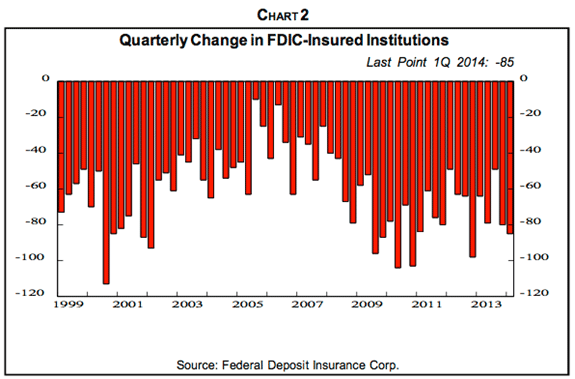
Many observers believe banks with less than $1 billion in assets are too small to cope with increased regulation. Last year, in 204 bank mergers, the target bank had assets under that level, about the same as the 206 in 2012 but up hugely from 102 in 2009 before the pressure to merge was fully felt. Not only Dodd-Frank regulations, but also the new “qualified mortgage” rules by the Consumer Finance Protection Bureau that insures borrowers can afford mortgages, are very costly for small banks.
Also, the number of bank branches continues to drop, in part due to mobile and electronic banking. Last year, 2,563 branches disappeared and reduced the total to 96,339 in mid-2013 (Chart 3). This is a far cry from the situation in the early 1960s when I was working on my Ph.D at Stanford and a girlfriend from the Chicago area was visiting me in the summer. She had a letter of introduction from Continental Illinois so she could cash checks at Bank of America, then entirely located in California. While filling out the Bank of America forms in San Francisco, she was stymied by the blank that called for the branch of her bank. Illinois at the time had only unit banking, one location per bank. The Bank of America officer in turn couldn’t understand her problem because of that bank’s statewide branch network.

Big Banks Balloon
Nevertheless, the largest banks’ share of assets continues to leap. It was propelled in the 1990s by the progressive relaxation and final elimination in 1999 of the Depression- era Glass-Steagall law that kept commercial banks out of investment banking. Then with the 2008 financial crisis, stronger big banks bought weaker competitors – with government encouragement, we might add. JP Morgan Chase took over failed Washington Mutual as well as Bear Stearns, Bank of America acquired mortgage lender Countrywide and Merrill Lynch, and Wells Fargo purchased Wachovia. At the end of 2013, the five largest institutions controlled 44.2% of total bank assets, up from 38.4% in 2007. As of March 31, 2014, those 107 institutions with over $10 billion in assets were only 1.7% of the total number but held 80.8% of all bank assets (Chart 4).
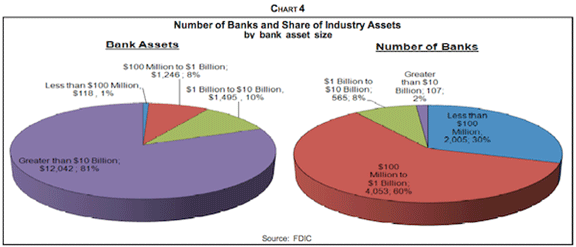
In addition, critics of big banks note that buyers of bank debt are more lax in their due diligence of a bank that’s too big to fail because they anticipate a government bailout if needed. This allows the leaders of these banks to borrow cheaply and take bigger risks in a self-feeding cycle of more leverage and more risks.
A recent New York Fed study found that big banks pay 0.31 percentage points less than smaller banks when issuing high-quality bonds, and an even bigger advantage in comparison with nonfinancial corporations where the spread is 0.5 percentage points. Similarly, the IMF reports a borrowing advantage of 0.6 percentage points for too-big-to-fail banks in Japan and the U.K. and 0.9 in the eurozone.
Furthermore, bank CEO pay is much more linked to size than performance. A recent study revealed that the eight U.S. “Systemically Important Banks” – Wells Fargo, JP Morgan Chase, Goldman Sachs, State Street, Bank of New York Mellon, Morgan Stanley, Citigroup and Bank of America – had a median stockholder total return (stock appreciation plus dividends) of 38% since 2009 while the return for smaller banks like US Bancorp, PNC and Sun Trust exceeded 100%. But the median total pay, including cash and stock awards of the large banks between 2010 and 2013, was $57 million compared with $35 million for the second tier. Sure, larger firms are more complex and harder to manage but they can make bigger mistakes, as shown by JP Morgan’s $6.2 billion loss with the London Whale, as we’ll discuss later. No wonder big bank CEOs resist dismemberment and want to grow even bigger!
Break-Up Proponents
Among those now advocating the breaking up of big banks is Sanford Weill, who, ironically, earlier led the charge to end Glass-Steagall so he could merge insurer Travellers, which he headed, with Citigroup. In fact, the Gramm-Leach-Bliley Act that killed Glass-Steagall was dubbed the “Citigroup Authorization Act.” In announcing his reversal in opinion in July 2013, Weill said, “I think the earlier model was right for that time. I think the world changed with the collapse of the real estate market and the housing bubble and what that did because ofleverage ofcertain institutions. So I don’t think it’s right anymore.” He also said, “I am suggesting that they be broken up so that the taxpayer will never be at risk, the depositors won’t be at risk.” And he admitted, “Mistakes were made.”
Others advocating the break-up of big banks include Philip Purcell, the former CEO of Morgan Stanley, Sheila Bair, the former head of the FDIC, John Reed, who ran Citigroup before it was merged with Travellers, Thomas Hoenig, former Kansas City Fed President and Dallas Fed President Richard Fisher. A number in Congress are also on board including Sen. Ron Johnson from Wisconsin.
Like unscrambling an egg, it’s hard to envision how big banks with many, many activities could be split up. But, of course, one of the arguments for doing so is they’re too big and too complicated for one CEO to manage. Still, there is the example of the U.K., which plans to separate deposit-taking business from riskier investment banking activities – in effect, recreating Glass-Steagall.
In any event, among others, Phil Purcell believes that “from a shareholder point ofview, it’s crystal clear these enterprises are worth more broken up than they are together.” This argument is supported by the reality that Citigroup, Bank of America and Morgan Stanley stocks are all selling below their book value (Chart 5). In contrast, most regional banks sell well above book value.
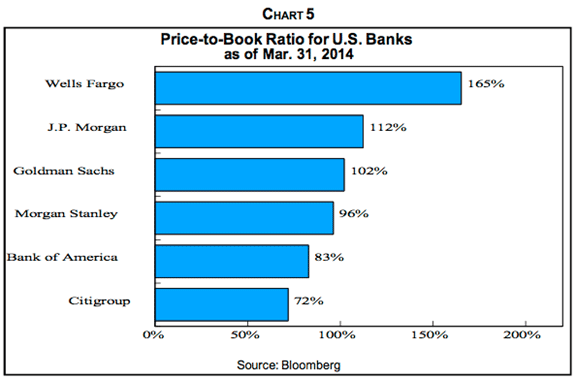
Push Back
Not surprising, current leaders of major banks have pushed back against proposals to break them up. They maintain that at smaller sizes, they would not be able to provide needed financial services. Also, they state, that would put them at a competitive disadvantage to foreign banks that would move onto their turf.
The basic reality, however, is that the CEOs of big banks don’t want to manage commercial spread lenders that take deposits and make loans and also engage in other traditional banking activities like asset management. They want to run growth companies that use leverage as their route to success. Hence, their zeal for off-balance sheet vehicles, proprietary trading, derivative origination and trading, etc. That’s where the big 20% to 30% returns lie – compared to 10% to 15% for spread lending – but so too do the big risks.
Capital Restoration
The strategy of big bank CEOs seems to be to fight break- up proposals tooth and nail in the hope that as memories of the 2008-2009 bailouts fade, so too will interest in reducing their size. Furthermore, the vast majority of banks, big and small, have restored their capital. Most banks are comfortably above impending capital requirements. At the end of the first quarter, 98.2% of all FDIC-insured institutions representing 99.8% of industry assets (and therefore all the big banks) met or exceeded the requirements of the higher regulatory capital category.
Nevertheless, the FDIC and Federal Reserve are planning a new “leverage ratio” schedule that would require the eight largest “Systemically Important Banks” to maintain loss-absorbing capital equal to at least 5% of their assets and their FDIC-insured bank subdivisions would have to keep a minimum leverage ratio of 6%. This compares with 3% under the international Basel III schedule. Six of these eight largest banks would need to tie up more capital. Also, regulators may impose additional capital requirements for these “Systemically Important Banks” and more for banks involved in volatile markets for short-term borrowing and lending. The Fed also wants the stricter capital requirements to be met by 2017, two years earlier than the international agreement deadline.
The number of institutions on the FDIC’s “Problem List” fell to 411 and the assets of those banks dropped to $126.1 billion in the first quarter. Bank failure numbers have yet to return to pre-crisis levels, but have dropped considerably since the 157 peak in 2010 (Chart 6). Similarly, the percentage of institutions with quarterly losses continues to fall while the percentage with quarterly earnings increases exceeds the pre-crisis level (Chart 7).
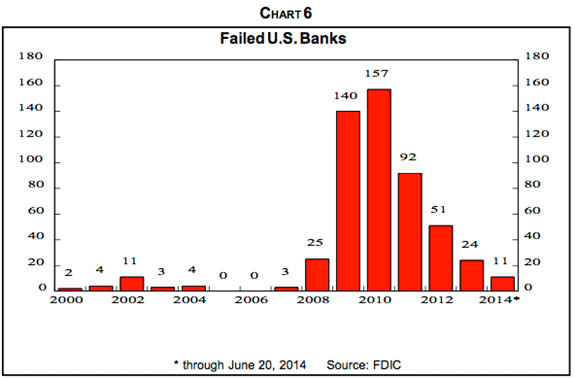
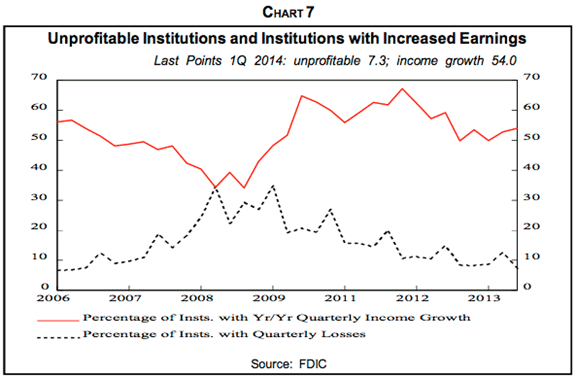
More Regulation
Despite the improving financial status of banks, especially larger institutions, their push back against being dismembered has been met with more regulation. The unvoiced strategy in Washington seems to be, if the big banks don’t agree to be broken up, they’ll be regulated to the point that they wish they were, or at least to the degree that individual failures are much less likely and far less damaging if they do occur. Slowly but surely, they’re being busted back toward spread lending and other traditional commercial banking businesses and bereaved of many risky but highly-profitable activities – highly-profitable until adjusted for risks. Consider the higher Basel III capital requirements, the pressures to orient executive compensation toward long- run risk-adjusted profitability and away from short-run speculation, the divestiture of non-core bank assets, the Volcker Rule, the selling ofbranches and subsidiary banks, etc.
Late last year, the FDIC prepared a plan to unwind large banks on the edge of collapse without taxpayer bailouts. The FDIC would keep parts of the bank open, prioritize payments to creditors and recapitalize the firm. “Unsecured creditors and shareholders must bear the losses of the financial company without imposing a cost on U.S. taxpayers,” said FDIC Chairman Martin Greenberg.
All of these new regulation proposals strike us as fighting the last war. With all the Dodd-Frank and other regulations now in place and the losses, chastisements and embarrassments of bankers, mortgage lenders, homeowners, etc., it’s unlikely that a repeat of the 2008 financial crisis and the speculation that spawned it will occur any time soon. That doesn’t mean that financial bubbles are extinct, but that the next one will occur in a different area that is outside the scope of the regulatory reaction to the last crisis. Besides, all those super bright, million-dollar per year guys and gals on Wall Street can figure out how to beat most $100,000 regulators any day!
Fed Proposals
Meanwhile, the Fed and the Office of the Controller of the Currency, another bank regulator, in March 2013 told banks to avoid funding takeover deals that would leave companies with high debts. But since then, “judging from aggressive market data, it appears that many banks have not fully implemented standards set forth” in March 2013, said a senior Fed official recently. In March of this year, the OCC said there would be “no exceptions” to the guidance for newly-issued loans. These junk “leveraged” loans have seen a rapid reduction in investor-protecting covenants that moves them back to previous day’s levels that proved disastrous when the 2008 financial meltdown hit.
In a similar vein, the Fed’s point man on regulations, Gov. Daniel Tarullo, said recently that after reading accounts of the role that money market and other short-term markets played in the financial crisis, a “broadly applicable” minimum margin requirement makes sense. Fed Chairwoman Janet Yellen also backs new rules for short-term funding to mitigate risks to the financial system.
The final version of the Volcker Rule has been delayed by haggling over the difference between genuine hedging of customer assets and proprietary trading with bank assets. The Volcker Rule isn’t expected to be implemented until 2015 and promises to be very specific as to what is and what isn’t a hedge. Meanwhile, Wall Street houses such as Goldman Sachs have exited their in-house trading.
More Examiners
Regulators are adjusting their staffs to better understand and control financial institutions’ activities. The New York Fed roughly doubled its supervision staff since the crisis and has between 15 and 40 overseeing each of the largest bank holding companies. The OCC, which regulates banks with national branch networks like JP Morgan and Wells Fargo, has upped its staff examining large banks by 20% since 2007, with up to 60 at the largest institutions. These examiners have access to computer systems and can attend internal strategy meetings and readily meet with bank executives and board members.
At the same time, the heat is on banks to beef up their compliance. Regulators are concerned that banks don’t comprehend their own operations, including measuring risks and planning for future crises. The OCC recently said that only two of 19 banks have met the standards it laid out after the crisis. Among other things, it wants two independent directors on boards of national banks and independent officers to track and monitor all business lines.
Large banks are hyping their compliance staffs. JP Morgan plans to add over 13,000 people and the industrywide hiring effort is creating a war for talent with escalating pay levels. Similarly, bank risk officers are multiplying like fruit flies as the OCC warns that “credit risk is now building after a period of improving credit quality and problem loan cleanup.” At major banks, their numbers are rising over 15% annually.
Wells Fargo now has 2,300 in its risk management department, up from 1,700 two years ago and the department's budget has doubled to $500 million. In contrast, the bank's total workforce has remained flat. Goldman Sachs put its chief risk officer on the 34-person management committee for the first time in the firm's 145-year history. Senior risk officer pay is up as much as 40% from a few years ago and equal to the compensation of chief financial officers and general counsels. Earlier, they were paid a third less.
Large banks are being pushed by regulators to specify in writing which risks and how much they're willing to take to meet financial goals. Risk officers are being urged to examine big losses or big profits for signs of undue risks.
The efforts of regulators and risk officers may be having significant effects. At the end of 2013, the five largest banks had $793 billion in equity capital to protect against losses, up 19% from $667 billion in 2009. At the same time, their value at risk, in effect their exposure to losses on any given trading day, fell 64% from $1.05 billion to $381 million
Who’s The Toughest?
Then there is the war among regulators to be the toughest. They’re chastised in and out of Washington for leveling billion-dollar fines that are still just a cost of doing business for major banks, for letting them off with mere “we neither admit nor deny” statements and for not sending individual bankers to jail. The relatively new SEC Chairwoman Mary Jo White promises to be a lot tougher, but the results are yet to be seen. The OCC recently detailed risk management standards for banks with over $50 billion in assets, which puts the monkeys on the bank board members’ backs and requires banks to have independent audit and risk management offices that can take their concerns directly to the board.
Then there’s the game of one regulator trying to deflect pressure by saying that other regulators are lax. The SEC has criticized the Financial Industry Regulatory Authority, which it oversees, for being too lenient in its sanctions. In the five years since the financial crisis, FINRA did not discipline any Wall Street executives and imposed fines of $1 million or more 55 times compared with 259 times for the SEC. FINRA regulated 4,100 brokerage firms and over 600,000 brokers and collected just $74.5 million in fines last year compared to $3.9 billion for the SEC. Note, however, that the SEC, not FINRA, takes the most serious fraud cases while FINRA concentrates on lesser infractions such as operations breakdowns where penalties are smaller.
Derivatives
Dodd-Frank has bereaved banks of much of their origination in trading in futures, options and other derivatives. Derivative trading is largely being transferred to exchanges that guarantee fulfillment of the contracts as opposed to the highly-profitable over-the-counter derivatives that banks trade but with which investors or speculators have to look to counterparties to be good for losses. This is the “counterparty risk” problem. Still, the seven largest banks still accounted for 98% of the $215 trillion notional value of derivative contracts as of March 31 (Chart 8), 85% of which were interest rate contracts (Chart 9).
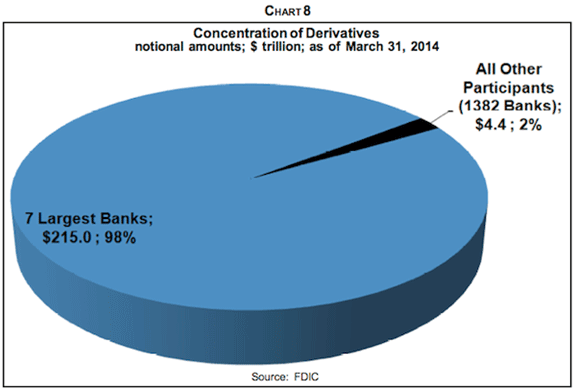
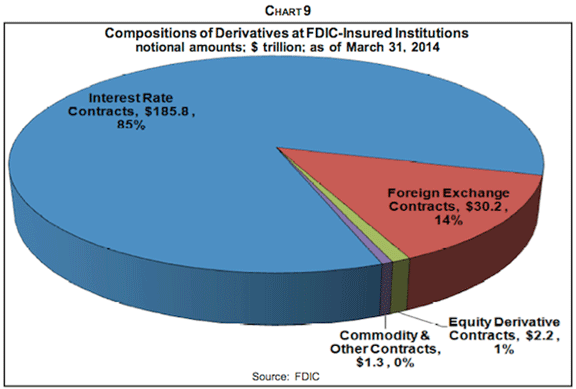
Still, regulators are concerned with derivatives. Those from 10 European and North American countries recently released a report that said many large banks and their regulators are still not ready to deal with difficulties in the huge derivatives market. They lack the information to consistently and accurately know who their counterparties are. Officials estimate that banks are up to three years away from having the necessary systems in place.
Dark Pools And High-Speed Trading
Another area of concern to regulators is dark pools, private trading venues that don't disclose their activities publicly and account for 14% of all stock trading. Another 23% occurs in other off-exchange locales. The purpose of dark pools is to facilitate large institutional trading without exposure to high-frequency traders. Barclays bank runs Barclays LX, the country's second largest dark pool, which is marketed with the motto, “Protecting clients in the dark.” But the New York Attorney General has charged that Barclays offered access to Barclays LX to high-speed traders. The bank is also accused of using other trading venues that benefit Barclays rather than its customers.
Under pressure from their institutional investor clients, many large brokers are routing trades away from Barclays LX and other dark pools. The SEC is investigating dark pools to determine whether they accurately disclose how they operate and whether they treat all investors fairly. Chairwoman White said in June that the size of off-exchange trading “risks seriously undermining” the quality of the U.S. stock market. Goldman Sachs recently agreed to pay an $800,000 fine for mispricing 400,000 trades in dark pool Sigma X in 2011. The firm already reimbursed clients with $1.67 million.
Citigroup Charades
One big bank that remains squarely in regulators’ gun sights is Citigroup, and for good reason. The present firm resulted from the merger of Citicorp and Travellers in 1998. Vikram Pandit left Morgan Stanley in 2005 after being passed over for CEO and, with two colleagues, started a hedge fund, Old Line. It was sold to Citigroup in 2007, right at the top of the financial bubble, for $800 million. Even though that hedge fund was not very successful and eventually closed, Pandit rose to be CEO of the firm in December 2007.
On his watch, the company’s stock continued its collapse from what would have been $564 per share in December 2006, except for the 10-to-1 reverse split in May 2011 to avoid the embarrassment of its selling at penny stock prices (Chart 10). The swoon to the trough in March 2009 was 98.2%.

Pandit’s relations with regulators were poor and he didn’t help matters by letting the bank consider completing the purchase of a private jet after receiving $45 billion in TARP bailout money. Despite his announcement to the Citigroup directors that all was well with regulators, the bank failed the Fed’s stress test in 2012. So it was not allowed to increase its quarterly dividend from one-cent per share to five cents and it requested but could not buy back up to $6.4 billion in stock. Shareholders were not amused and Pandit was shown the door in October.
Pandit told Congress in February 2009 that “my salary should be $1 per year with no bonus until we return to profitability.” After some improvement in the bank’s finances, he was awarded a $23.2 million retention package in 2011, close to the top of CEO compensation. Nevertheless, in April 2012, 55% of shareholders voted against increasing his pay to $15 million, the first nonbinding rejection of a compensation plan by a major bank.
History Repeats
In a repeat of history, last March the Fed again said Citigroup flunked its stress test, only the second bank along with Ally Financial to fail twice. So it can’t raise its quarterly dividend from one-cent to five cents per share.
It wasn’t the quantitative part of the test that tripped up Citigroup. Its Tier 1 capital ratio would only fall to 7% under very adverse conditions, still well above the fed’s 5% minimum. That adverse scenario, specified by the Fed, includes a deep recession with leaping unemployment, a steep decline in house prices and a 50% plummet in equity prices. Also, in the third annual stress test, the Fed made its own projection of the bank’s balance sheet, assuming the assets rise during tough times rather than fall as banks had assumed, so more bank capital would be necessary. In addition, the Fed forced eight big banks to assume the default of their largest counterparty.
The Fed this year flunked Citigroup on the quantitative side of the stress test. It cited deficiencies in Citi’s capital-planning process and risk assessments. The Fed had earlier warned the bank about these problems, but received an inadequate response. In effect, the Fed is questioning whether Citigroup is too big and too complex to manage without posing systemic risk.
The London Whale
In failing Citigroup in its stress test, the Fed has yet to bring up the bank’s risks controls in Mexico and the Banamex loss. But the Fed and other regulators have been clear over JP Morgan Chase’s lack of controls that led to the London Whale disaster in 2012.
Banks normally invest funds they’re not using for loans in Treasurys, but with low interest rates, JP Morgan became aggressive. As an example, at the end of 2006, it held $600 million in riskier corporate debt, or about 1% of total investments, but jumped those holdings to $10 billion, or 5% of all security holdings, two years later, and $62 billion, or 17% of the total, at the end of 2008 after the Fed initiated its zero interest rate policy. Similarly, non-U.S. residential mortgage security holdings jumped from $2 billion at the end of 2008 to $75 billion in early 2012. At the time, CEO Jamie Dimon disputed the idea that the bank was taking on more risk. “I wouldn’t call it more aggressive. I would call it better,” he said.
Meanwhile, the bank’s culture of risk-taking – and we believe the tone in any organization is set at the top – was rampant in London. A JP Morgan bank trader, Bruno Iksil, was making huge bets totaling $82 billion, with insurance-like derivatives called credit default swaps so big that he became known as the London Whale. That attracted hedge funds to take the other side of his trades, figuring he’d have to unwind them sooner or later. Meanwhile, his boss was urging him to put even higher values on his positions. When asked about this trading on April 13, 2012, Dimon said concerns were “a complete tempest in a teapot.”
Then came revelations of losses of at least $2 billion and Dimon began to realize the extent of the problem. “There’s blood in the water – hedge funds are going to come after us and make it worse,” he was told by a colleague. And they did, with the loss leaping to $6.2 billion by July. Dimon tried to get ahead of the bad public relations by stating that the trades were “flawed, poorly executed, poorly reviewed and badly monitored.”
The Chief Investment Office in which these trades took place was supposed to manage and hedge the firm’s fixed- income assets. But it has become clear that the CIO was taking directional bets and speculating in contradiction of the impending Volcker Rule. In 2011, risk-control caps that had required traders to exit positions when their losses exceeded $20 million were dropped. Subsequently, Dimon admitted as much, saying, “What this hedge morphed into violates our own principles.” Also, he was slow to fire Ina Drew, who was responsible for the CIO, and he dithered about clawing back the $14.7 million in stock awards she received.
Bones And Joints
Furthermore, Dimon, the bank and Wall Street faced huge fallout from this mess. He has led the charge against the Volcker Rule and other new bank regulations and had considerable credibility in Washington and on Wall Street because his bank largely avoided the near-financial meltdown.
Dimon was known as the smart, hands-on operator who says he knows all the “bones and the joints” of the bank. Is his being shocked! shocked! to discover the $6.2 billion loss proving what many regulators and legislators believe: that big banks are too complicated to manage and should be broken up? If they’re too big to fail, it’s ironic that when asked, in hindsight, what he should have paid more attention to, Dimon quipped, “Newspapers,” no doubt referring to the April 6, 2012 front page Wall Street Journal story about the London Whale.
Furthermore, the London Whale fiasco has not hindered Dimon’s compensation, although he suffered a pay cut at the time. In January 2014, the JP Morgan board raised his pay 74% to $20 million for 2013, a year in which the bank agreed to more than $20 billion in fines and other legal payouts and suffered its first quarterly loss in nine years. In making that award, which included $18.5 million in stock, the board cited “the regulatory issues the company has faced and the steps the company has taken to resolve those issues.”
Well, in contrast to Citigroup, JP Morgan’s stock fell “only” 70% during the financial crisis. Since then, it has rallied 260% to now exceed the May 2007 peak by 8%. And investors didn’t have lasting concerns over the 2012 London Whale losses and lack of controls. Regulators, however, may have the last word.
Fines
That lack of investor worry comes despite the huge fines and other penalties being paid by JP Morgan and other big banks over bad mortgages, manipulation of currency, interest rate and commodity markets, and illegally helping Americans to avoid taxes.
The CFTC and JP Morgan settled for $100 million in the London Whale case after the regulator charged the bank with reckless use of manipulative devices. The bank also acknowledged wrongdoing as part of the $970 million settlement with the SEC, OCC, the Fed and U.K. regulators in September 2013 in the same case.
The SEC got $200 million of that total and admissions by JP Morgan that it misstated its first quarter 2012 financial results, failed to properly oversee its traders and didn’t keep its board of directors informed about the trading problems. This is only the second time, after the settlement with hedge fund company SAC, that the SEC obtained admission of wrongdoing and it is in line with Chairwoman White’s promise to get tough and get more admissions. Earlier, U.S. District Court Judge Jed S. Rakoff rejected a $285 million settlement the SEC negotiated with Citigroup, in part because Citi did not admit liability.
BNP
Big foreign banks with U.S. operations are not beyond the reach of American regulators. France’s largest bank, BNP Paribas, has finally agreed to pay $9 billion in penalties and plead guilty to criminal charges over concealing about $30 billion in oil and other transactions with countries that are sanctioned by the U.S. including Iran, Cuba and Sudan. Also, as demanded by New York State regulators, 30 people will leave the bank. Starting in January, the bank will lose its permission to clear certain dollar transactions for a year. The alternative to accepting these harsh sanctions was being banned from done business in lucrative U.S. financial markets.
Since French banks dominate trade financing and these transactions between the Americas and Asia are carried out in U.S. dollars, this last penalty is especially meaningful for BNP, although the bank has six months to arrange a transition to other firms that will handle this business during BNP's absence. French President Francois Hollande called the demands by U.S. regulators “unfair and disproportionate,” but with classic French face-saving, Finance Minister Michel Sapin took credit for the limited scope of the dollar ban. “In line with the demands of the French authorities, this agreement sanctions the activities of the past and protects the future,” he said.
Prosecutors in the Justice Department and Manhattan District Attorney’s office were especially irked by BNP’s slow and incomplete response to their requests for documents and interviews in 2009 concerning transactions that took place between 2002 and 2009. U.S. authorities believe that BNP employees took deliberate steps over several years to hide their dollar transactions with U.S.-sanctioned countries. Transactions were run through intermediate banks to avoid detection, in schemes that resemble money-laundering. BNP apparently did not expect this big of a fine since it reserved only about $1.1 billion. It plans to maintain its dividend and its stock rose 3.6% on the news, although it had dropped 18% since February when the bank announced the provision for possible U.S. fines....
... SUBSCRIBE TO INSIGHT AND YOU'LL GET A COPY OF GARY SHILLING'S FULL REPORT ON LARGE BANKS – FOR FREE!
Like Outside the Box?
Sign up today and get each new issue delivered free to your inbox.
It's your opportunity to get the news John Mauldin thinks matters most to your finances.
John Mauldin Archive |
© 2005-2022 http://www.MarketOracle.co.uk - The Market Oracle is a FREE Daily Financial Markets Analysis & Forecasting online publication.



